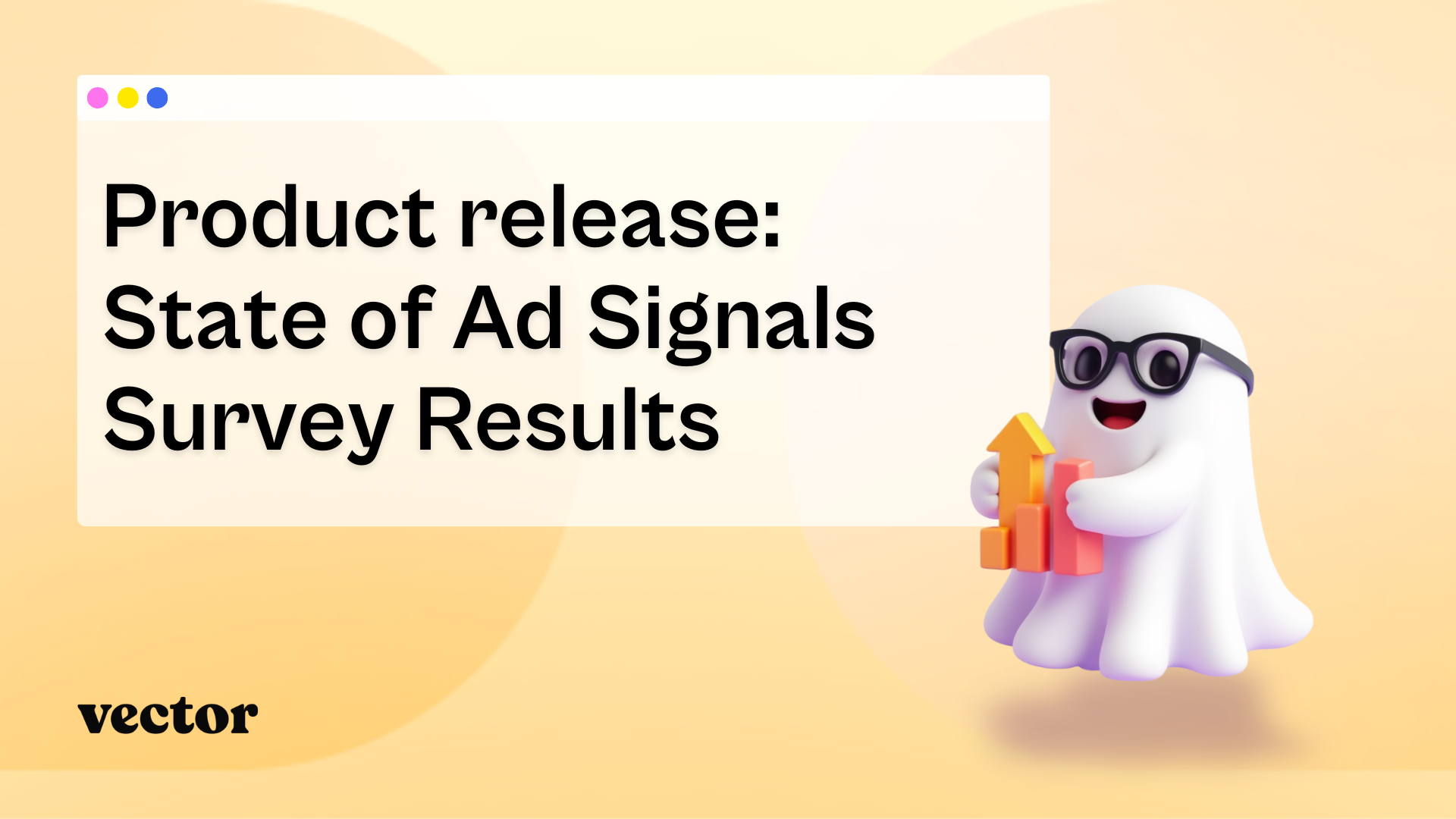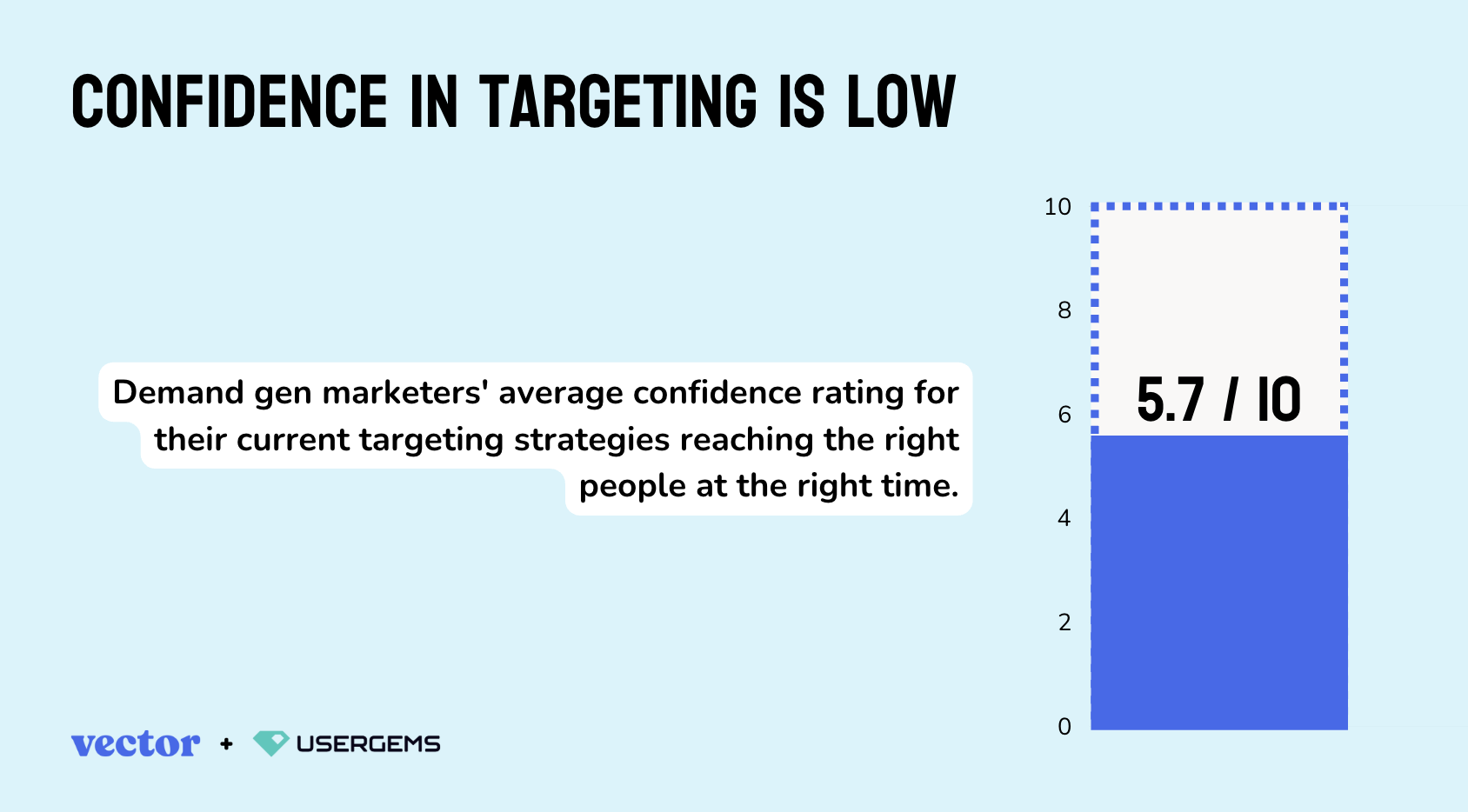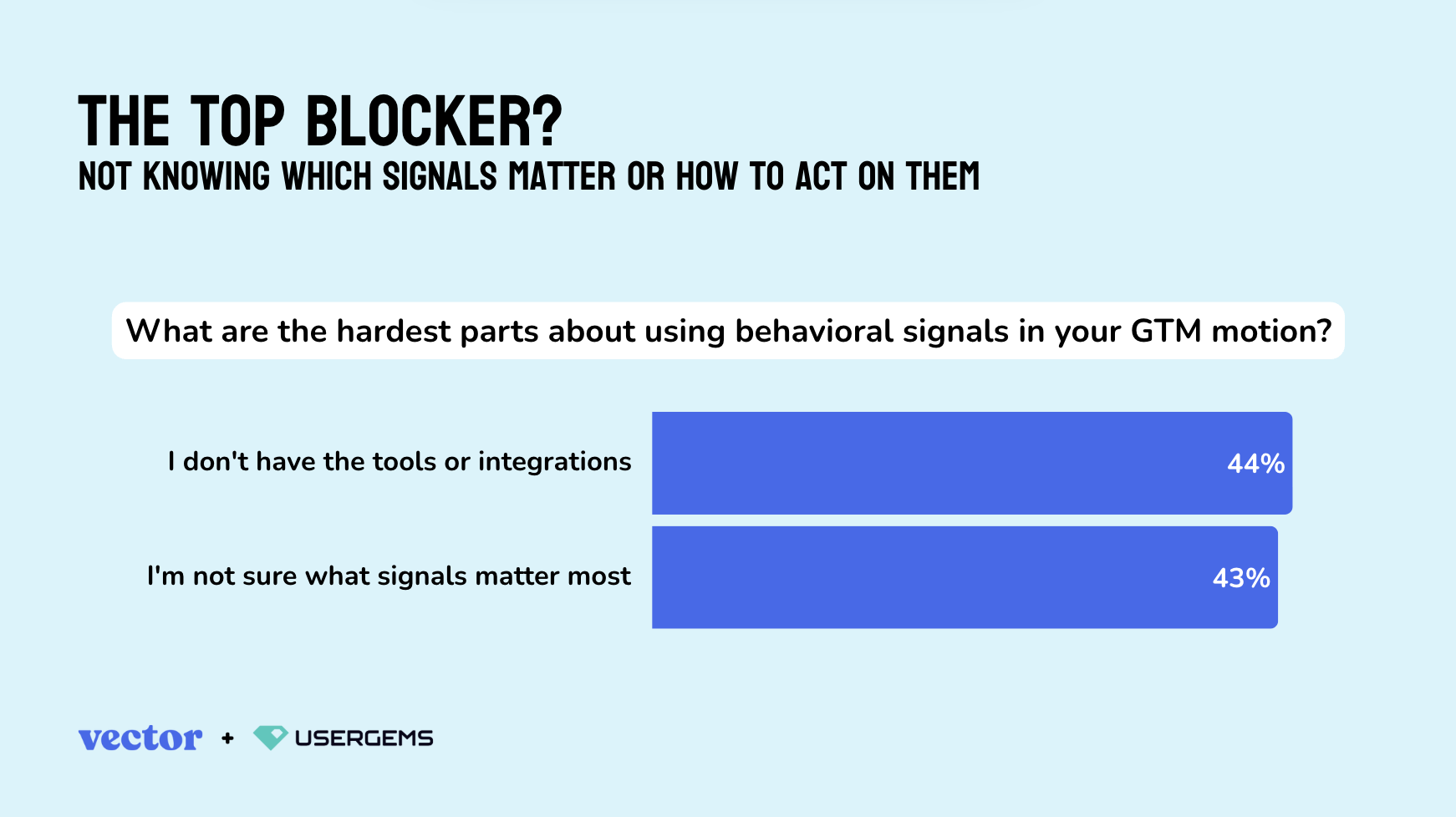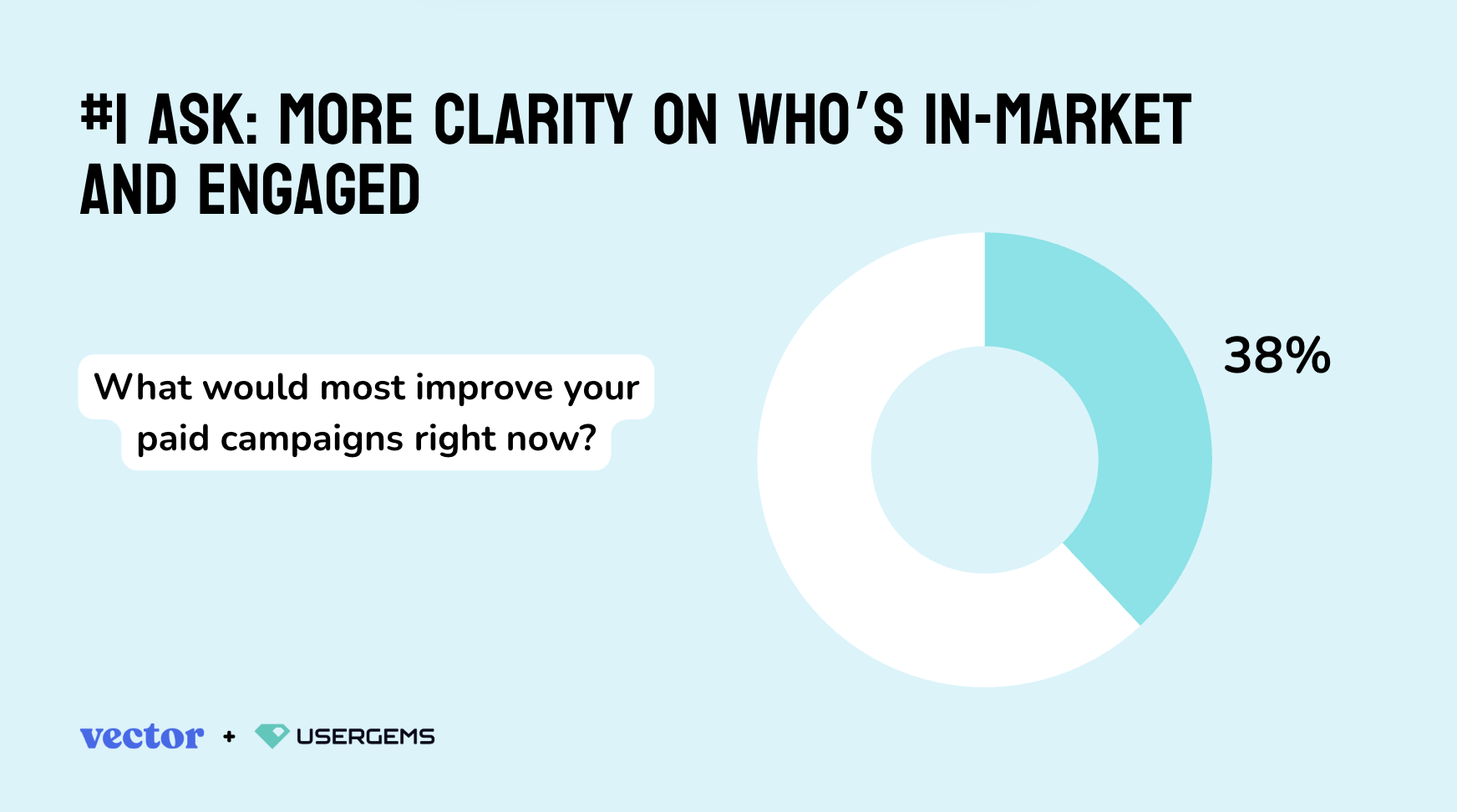Clueless? As if. The state of ad signals

Our State of Ad Signals survey (n=80) and the companion discussion with Jess Cook (Vector) and Isaac Ware (UserGems) point to a familiar reality:
plenty of data, not enough signal clarity.
Average confidence in “right person, right time” targeting landed at 5.7/10—not a disaster, but not exactly a makeover moment either.
Every B2B marketer is “data-driven.”
Dashboards? Many. Tools? Abundant. But targeting still sometimes feels like picking an outfit in low lighting. So we got into the details.
The verdict: strong on the basics; lighter on the timing signals that unlock precision.
.gif)
The Uncomfortable Truth:
Confidence Is… Fine, Not Fabulous

Asked whether current targeting reaches the right people at the right time, marketers averaged 5.7/10. Only 13.8% believe their strategy captures most in-market buyers; 61.2% say no, 25% aren’t sure. Alignment between paid and outbound on buyer readiness? A middling 5.0/10.
Do you find this surprising? Isaac Ware, ABM leader at UserGems, did during our "State of Ad Signals" discussion.
Why? Marketers' confidence in right people, right time.
From his seat, he felt like most teams still lean on broad, non-contact platform audiences (titles, company size, interests). That gets you people who look right—but not people who are ready. As Isaac put it, right-time targeting is still the exception because the inputs are mostly static. Titles don’t change week to week; buyer readiness does. As if a job title alone could tell you timing.
What goes wrong with broad audiences
- Reach ≠ readiness. Platform filters hit “Directors at SaaS companies,” but miss signals like recency/frequency of research or a buying event (e.g., renewal coming up).
- Algorithm smoothing hides waste. Audience expansion/lookalikes boost CTR but often drift away from true buying moments.
- No human handshake. Non-contact ads can’t sync with outbound; Sales emails people A/B/C while ads hit X/Y/Z.
Live footage of what happens when targeting goes wrong:
.gif)
What right-time actually looks like
- Contact-level triggers (pick 2–3 to start):
- Job change of a known champion or evaluator
- Renewal-due × competitor research overlap
- High-intent web streaks (pricing/demo pages 2–3× in 14 days)
- New stakeholder joins buying committee (role added in CRM)
- Recency × frequency × context measured at the person level, then mirrored in ads and outreach: same people, same story.
Signal 101 vs. 301

What we use most to build audiences:
- Website/page engagement (77.5%)
- Firmographics (76.2%)
- CRM activity (65%)
- Ad click behavior (52.5%)
What’s underused (but timing-rich):
- Job changes (30%)
- Off-site research intent (26.2%)
When asked what actually drives pipeline, the top three were Website/SEO (48.8%), Events (45%), and Paid media (42.5%)—solid staples.
But what can you do to improve?
Start with one high-leverage signal, ship it, then layer the next.
Here are some examples from Isaac and Jess (full recording here):
- Pick one “low-lift, high-signal” trigger.
Isaac: start with what’s easiest to stand up and most telling—job changes, revived closed-lost, or new ICP hires—then push those contacts straight into ads to match sales motion.
- Ship first, then add layers.
Jess: treat this like a crawl-walk-run. Prove one signal, then layer the next (e.g., add competitor-research audiences once the job-change play is humming). Think “build the outfit, then accessorize.”
.gif)
- Mirror outbound; avoid broad blasts.
Isaac: target the same-named contacts your reps are multi-threading, so ads reinforce real outreach. Broad, non-contact platform audiences appear to be on target, but they rarely hit the right time.
- Make it easy to operate.
Isaac: pull a simple CRM view (e.g., Salesforce report) as your input, sync to LinkedIn, and keep creative specific to the trigger (congrats + “first 90 days” for job changes; calm, value-forward copy for revived closed-lost).
- Keep score on movement, not clicks.
Jess: judge the play by stage progression, saves/expansion, and opp creation—not CTR. If it moves deals, it stays. If not, swap the layer.
What’s Actually in the Way

The blockers aren’t a lack of data—they’re plumbing and clarity:
- Tools/integrations (46.2%)
- Unsure which signals matter (43.8%)
- Data trust (38.8%)
- Too manual/time-consuming (37.5%)
- Don’t know how to activate (22.5%)
Top fix marketers want right now: More signal clarity (who’s in-market, who’s engaged).

What the room agreed on: Most teams aren’t short on data—they’re short on a repeatable way to turn existing signals into action.
Where teams stall
- Jess Cook (Vector): The gap is operational, not conceptual—no shared definition of “in-market,” fuzzy ownership, and no simple path from CRM/signal tools into ads and outreach.
- Isaac Ware (UserGems): Marketers hit analysis paralysis: tons of viable signals, no DRI to wire one end-to-end, so nothing ships. Broad platform audiences feel safer, but they miss timing.
What “activation” actually means
- Jess: Agree on one plain-English definition (recency × depth × role), then decide who pushes which list where every time.
- Isaac: Treat signals like a “layer cake”: stand up one trigger, route it, measure movement, then add the next.
- A 30-minute unblock (Isaac’s flow)
- Inventory the fields you already have (CRM + any signal tool).
- Pick one high-leverage trigger (e.g., job change, revived closed-lost, new ICP hire).
- Build a simple CRM report/list as your source of truth.
- Sync that list to ads and set a single owner alert (Slack/email) for outreach.
- QA 10 records weekly; keep if it moves stages/opps, swap if it doesn’t.
Ownership beats more tooling
- Jess: Make one person the DRI for each trigger (list freshness, exclusions, and delivery).
- Isaac: Keep creative matched to the signal (e.g., “congrats + first-90-days” for job changes) so ads echo the human move.
Up at night Issues
Budgets cluster where audience quality is obvious—LinkedIn (48.6%) and Google Search (37.8%)—so sloppy lists get expensive fast. As if you could hide a weak audience in those channels.
What’s keeping marketers up at night:
- Missing pipeline targets — 33.8% (the clear #1)
- Wasting budget on low-quality leads — 20%
Spend is concentrated where precision (or the lack of it) shows instantly, so tightening signal clarity and timing isn’t nice-to-have; it’s budget insurance.
How Contact-Based Advertising helps
- Clarity over volume: identify who is researching your space or competitors not just that “someone” hit a page. That maps to the #1 marketer request for paid improvements.
- Closer to revenue: tie opportunities back to people and their research patterns, useful when “missed pipeline” is the top fear.
- Buying-committee visibility: move beyond firmographics to decision-makers and influencers, reducing waste from generic lists.
- Make competitor intent actionable: reach the specific contacts doing comparisons and respond with helpful, honest context (as in the webinar examples).
.gif)
Bottom line
B2B marketers aren’t clueless; we’re just juggling A LOT.
The survey and the discussion during "State of Signals" agree: get crisp on who’s truly in-market, prioritize timing signals, and activate one shared audience at a time.
Broad audiences? Spray-and-pray advertising?
.gif)
Contact-based advertising is how a 5.7 turns into steady, repeatable wins.
Get the full walk through of Vector and UserGems ad strategies (including ad creative!) below.
Ad targeting
doesn't have to be
a guessing game.
Turn your contact-level insights into ready-to-run ad audiences.
Frequently asked questions



